Last Updated on July 7, 2023 by lindseymahoney
Tucked away in the idyllic countryside, English cottage gardens exude charm and character like no other. With their burst of colors, fragrant blooms, and meandering paths, these gardens are a true testament to nature’s beauty.
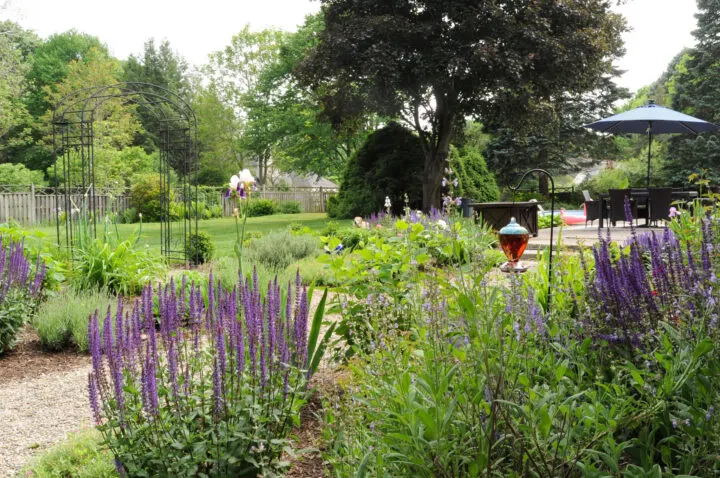
But you don’t need to live in the English countryside to enjoy the magic of a cottage garden. In this article, we’ll show you how to create your own slice of paradise right in your backyard.
The secret to an enchanting English cottage garden lies in its informal design and curated plant selection. We’ll guide you through the process of selecting the right plants, arranging them in a harmonious way, and creating charming pathways to meander through your garden.
Whether you have a small patio, a spacious lawn, or an urban balcony, you can transform any outdoor space into a whimsical retreat that brings you closer to nature. So grab your gardening gloves and let’s create your own English cottage garden to enjoy at home.
The History and Characteristics of English Cottage Gardens
English cottage gardens have a rich history that dates back to the 14th century.
Originally, these gardens were created by peasants who lived in small cottages and relied on their gardens to provide food and medicinal herbs. Over time, these practical gardens evolved into the romantic and picturesque spaces we know today.
Characterized by their informal design, English cottage gardens are known for their abundance of flowers, mixed borders, and charming features.
Unlike formal gardens with strict symmetry and manicured lawns, cottage gardens embrace a more relaxed and natural approach. They are designed to look as though they have evolved over time, with plants spilling over pathways and fences, creating a sense of wild beauty.
Choosing the Right Location for Your Garden
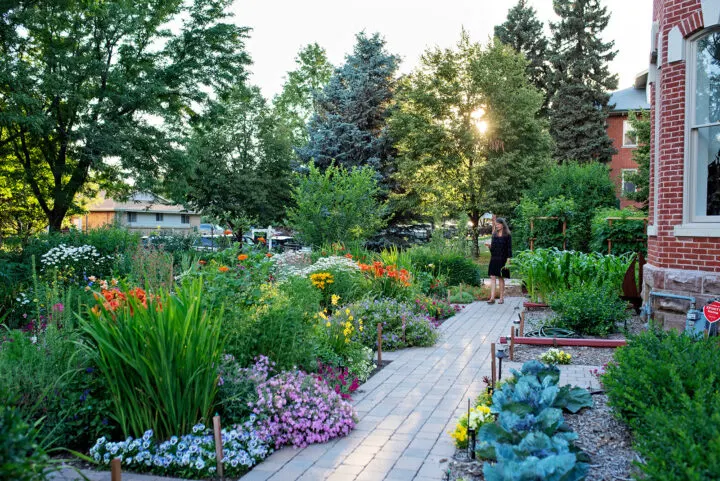
Before you start digging, it’s important to choose the right location for your English cottage garden. Most cottage gardens thrive in areas that receive at least six hours of sunlight per day. Take note of the sun patterns in your yard and select a spot that gets the most sunlight.
*Looking to plant a garden in a shaded area of your yard? Check out these beautiful shade garden ideas!
In addition to sunlight, consider the soil quality and drainage in your chosen location. Cottage garden plants generally prefer well-draining soil, so if you have heavy clay soil, you may need to amend it with organic matter to improve drainage.
It is important to consider the size and shape of your garden as well. Consider the available space and how you plan to use it.
If you have a small yard, you can create a cozy cottage garden in containers or raised beds. If space is not an issue, you can design a larger garden with winding pathways and seating areas.
8 Essential Elements of an English Cottage Garden
To create an authentic English cottage garden, it’s important to incorporate the essential elements that define this style. These elements include:
1 | Native Plants and Mixed Borders
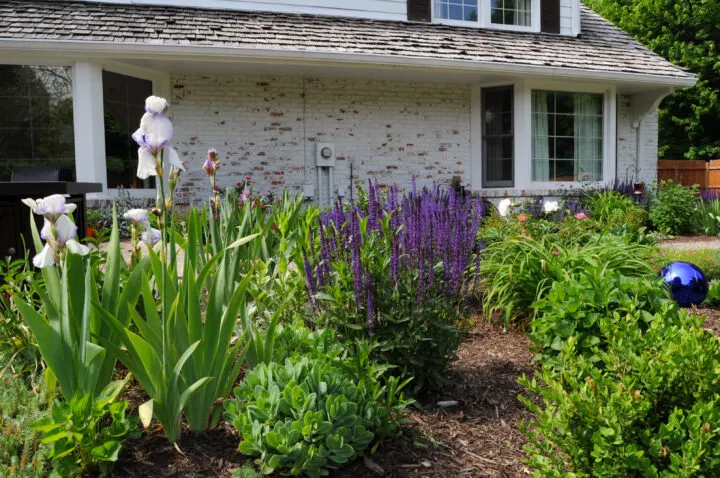
When planning your garden, choose plants that are native to the climate and soil where you live. Native perennials and annuals are much easier to care for because they thrive in a specific climate.
Add vertical interest to your garden by incorporating climbing plants, such as roses, clematis, or honeysuckle. These plants can be trained to grow up trellises, fences, or arches, adding a romantic touch to your garden.
Cottage gardens are also known for their mixed borders, where flowers, shrubs, and herbs are planted together in a seamless blend. Aim for a mix of colors, heights, and textures to create visual interest throughout the seasons.
Selecting the Right Plants for Your Garden
Choosing the right plants is crucial to the success of your English cottage garden. Aim for a diverse mix of plants that bloom at different times of the year, ensuring that your garden looks beautiful throughout the seasons.
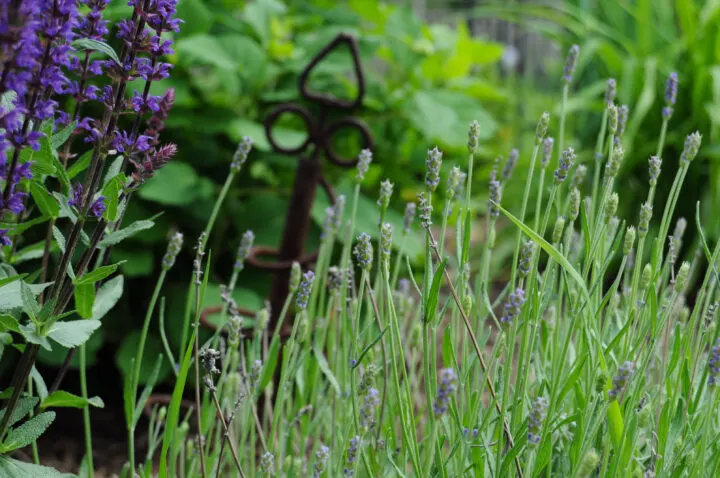
Start by selecting a variety of perennials, such as roses, peonies, lavender, and delphiniums. These plants will come back year after year, providing a reliable source of color and fragrance.

Mix in some annuals, like cosmos, zinnias, and sunflowers, for an extra burst of color.
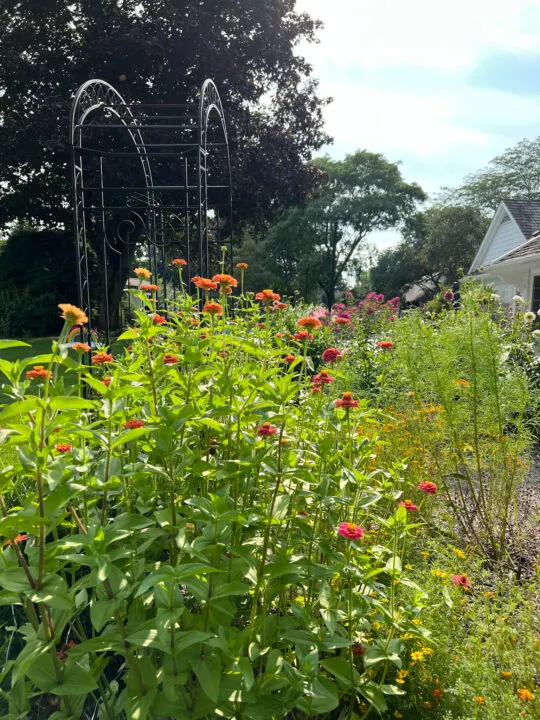
Don’t forget to include herbs and vegetables in your garden as well. Not only will they add texture and interest, but you’ll also have fresh herbs and produce right at your fingertips.
When selecting plants, consider their height and spread, as well as their sunlight and water requirements. Group plants with similar needs together to ensure they thrive. Research the specific growing conditions and care requirements for each plant to maximize their success in your garden.
2 | Winding Pathways
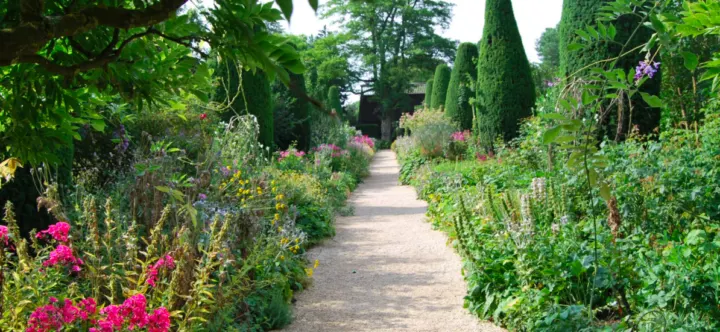
Pathways with natural materials look much more organic and relaxed compared to precise concrete sidewalks.
Cobblestone, brick, or pea gravel walkways look incredibly charming when included in an English garden design.
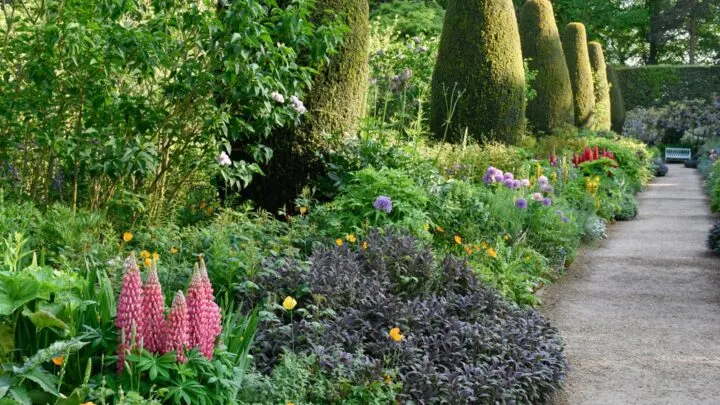
Along with winding pathways, stone retaining walls can also be found in many English cottage gardens. I love how these walls create the feeling of a secret garden.
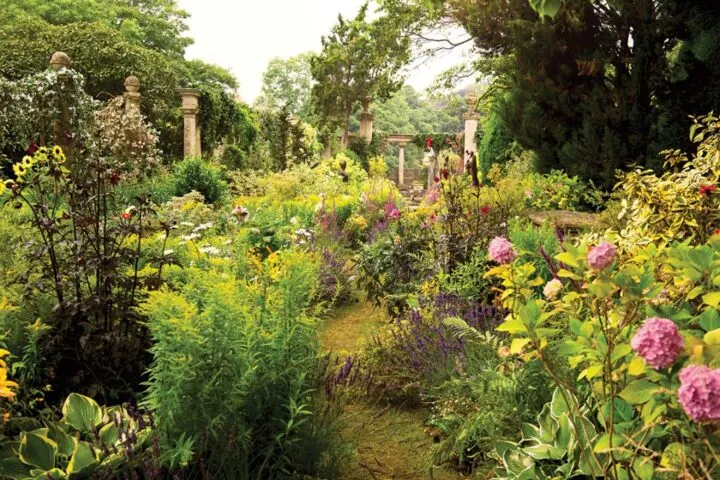
3 | Water Features
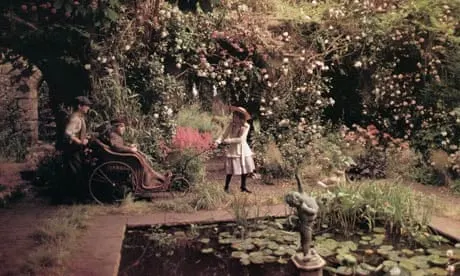
English gardens are an oasis for pollinators and birds. Include water features that invite pollinators and birds to stay awhile in the garden.
Adding a simple birdbath to your garden can do the trick, or building a small pond. If you are lucky enough to have a stream running throughout your property, consider incorporating it as you create your English garden design.
4 | Natural Materials – Stones / Pebbles /Pea Gravel
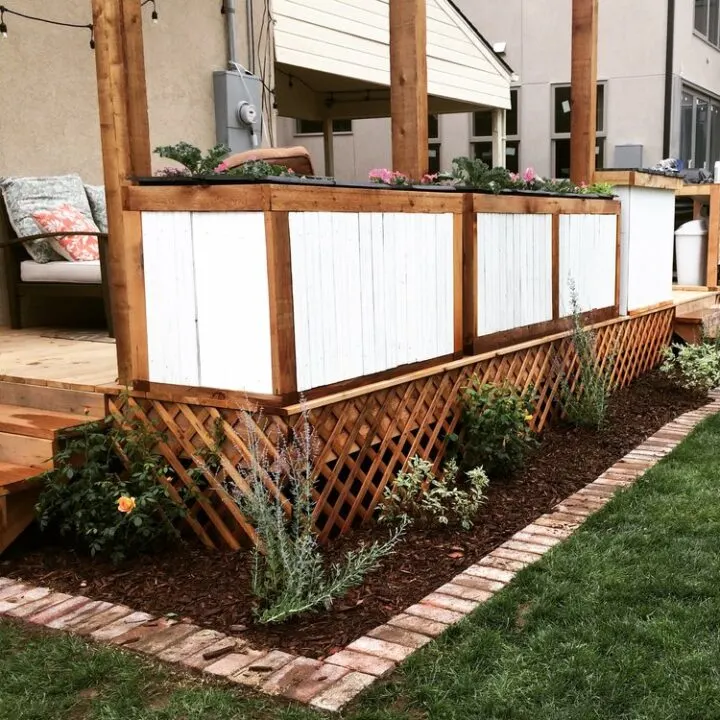
Adding natural stones to a garden helps to create that casual feeling you want to achieve. I love the look of brick borders or edging to create more structure for a large garden while still feeling informal.
The varying colors in bricks are a lovely touch to border overflowing flowerbeds with greenery and flowers.
5 | Arbors and Arches
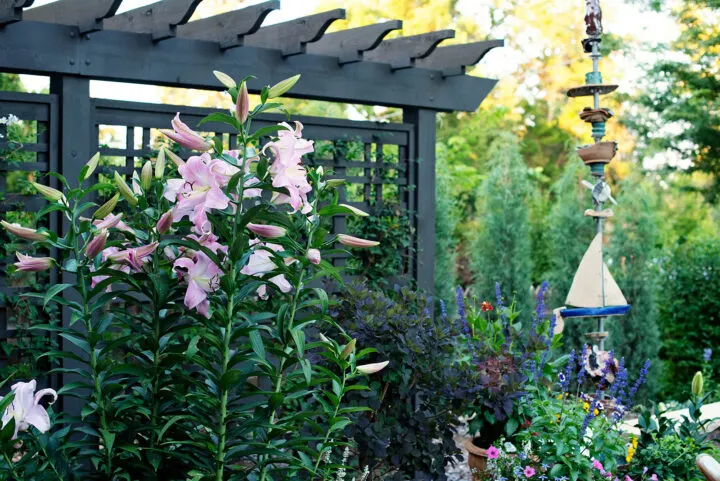
Arbors are the perfect place for climbing plants to really show off.
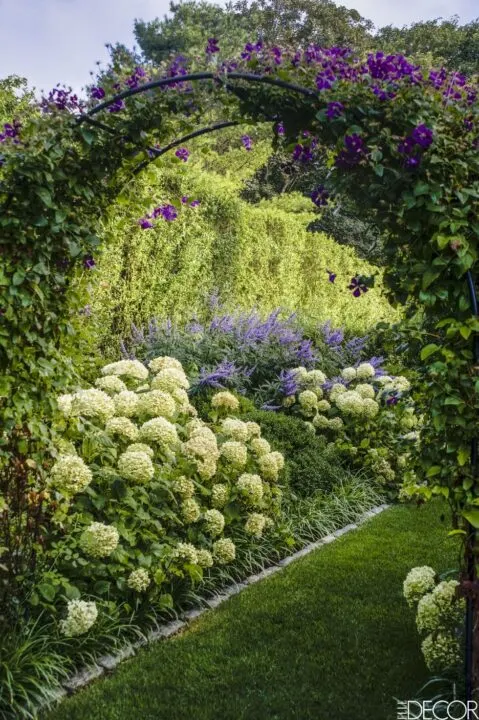
It is common to see plants like climbing roses, hydrangea, or clematis, surrounding an iron or wood arbor.
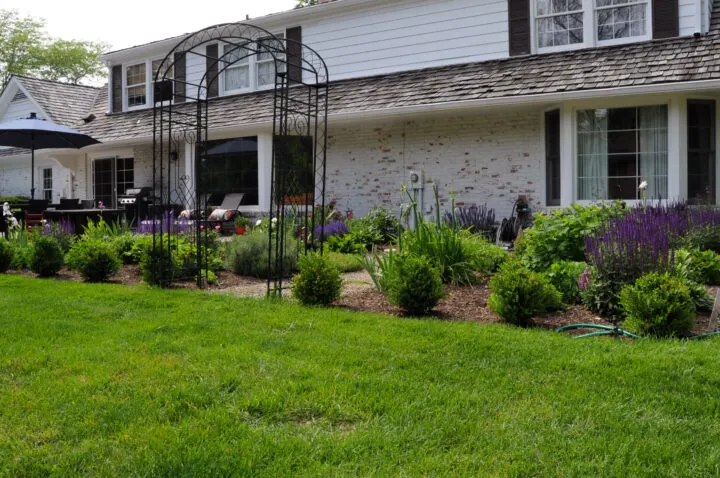
I found this old iron arbor on the side of the road and fixed it up for our own English garden. With a little sanding and black spray paint, this arbor is as good as new!
Soon I will plant climbing hydrangea to begin winding up the iron sides.
6 | Garden Seating Areas
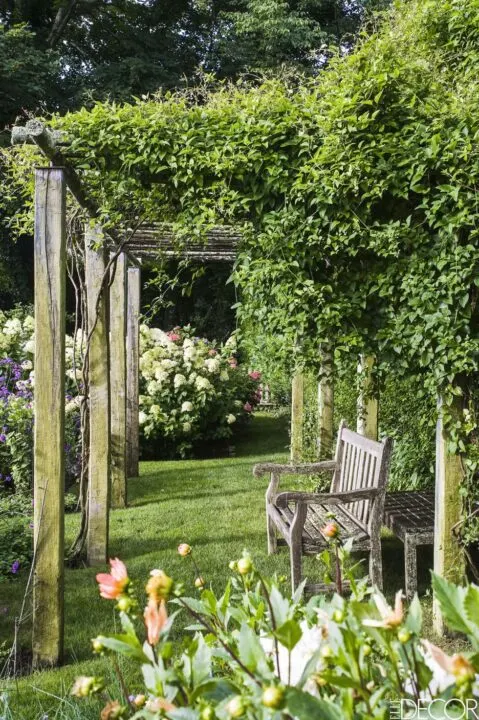
Include seating areas where you can relax and enjoy the beauty of your garden. This can be a simple bench tucked away in a quiet corner or a cozy patio set surrounded by blooming flowers.
Whether it is a weathered, wooden chair or a concrete bench, these gardens welcome visitors to sit and enjoy the view.
7 | White Picket Fence or Iron Fence
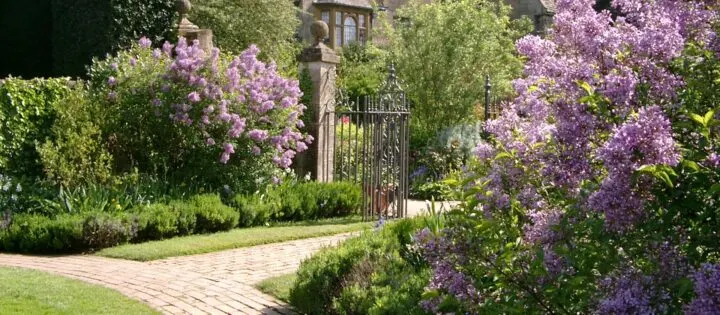
So many inspirational photos I pinned include a white picket fence as the backdrop of an English garden.
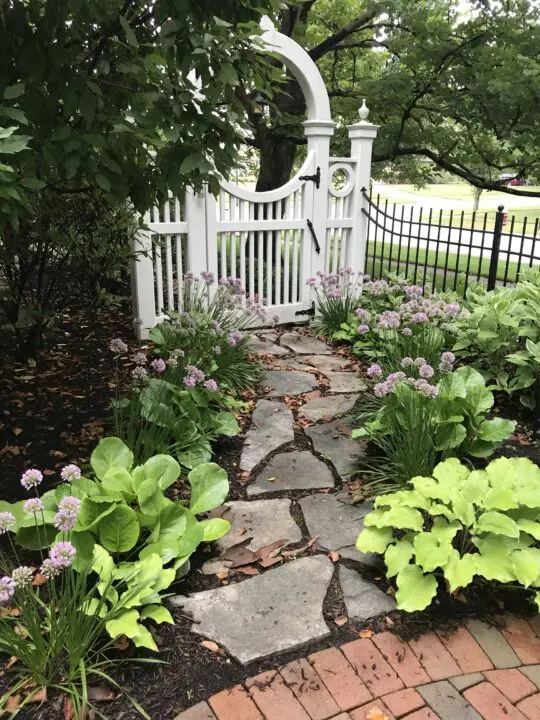
Oftentimes, these fences are slightly weathered, which adds to the feel of a casual garden. Iron fencing or gates are also commonly found in these gardens.
8 | Whimsical Garden Decor
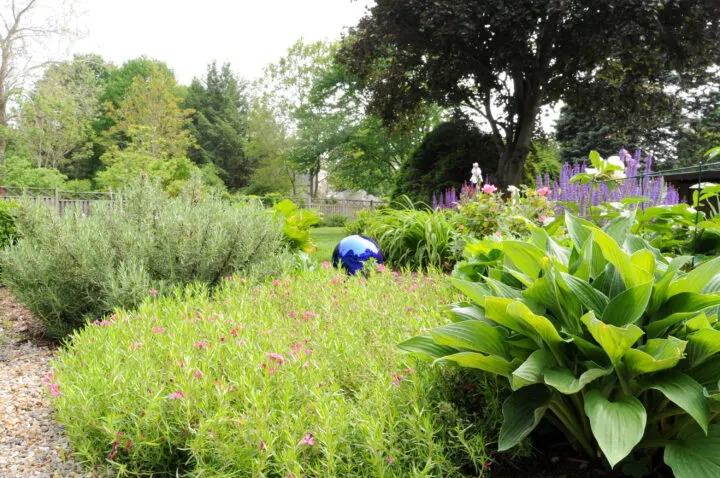
Including a few sculptural elements add to the fun of this style of gardening.
Items like colorful spheres, a small concrete sculpture of a garden critter, or hummingbird feeders can surprise and delight guests while walking through your English garden.
Creating your own English cottage garden is a labor of love that rewards you with a slice of paradise right at your doorstep. By embracing the informal design, carefully selecting plants, and incorporating charming features, you can create a garden that is not only visually stunning but also attracts wildlife and provides a peaceful retreat.
Remember to choose the right location for your garden, select a diverse mix of plants, and design and arrange your garden with care. Regular maintenance and attention will ensure that your cottage garden thrives and continues to enchant you for years to come.
Enjoy the beauty and process of growing your own English cottage garden!
Benefits of Creating an English Cottage Garden
There are numerous benefits to creating an English cottage garden. First, it is beautiful and is a peaceful sanctuary right in your own backyard. The beauty and tranquility of a cottage garden can help reduce stress and improve your overall well-being.
Second, cottage gardens attract a wide variety of wildlife, including butterflies, bees, and birds. By providing a diverse range of plants and habitats, you’ll be supporting local ecosystems and promoting biodiversity in your area.
Lastly, an English cottage garden adds value to your property. Its charm and beauty can enhance the curb appeal of your home, making it more attractive to potential buyers.
Whether you plan to stay in your home for years to come or eventually sell it, a well-maintained cottage garden is a valuable asset.
Maintaining and Caring for Your English Cottage Garden
Maintaining an English cottage garden requires regular care and attention. Here are a few tips to keep your garden looking its best:
1. Watering: Most cottage garden plants prefer moist soil, so water regularly, especially during dry spells. Avoid overhead watering, as it can promote disease. Instead, water at the base of the plants to ensure the roots receive enough moisture.
2. Mulching: Apply a layer of organic mulch around your plants to help retain moisture, suppress weeds, and improve soil fertility. Use materials like shredded bark, compost, or straw as mulch.
3. Deadheading: Remove spent flowers regularly to encourage continuous blooming. Deadheading also prevents plants from going to seed, which can reduce their vigor.
4. Pruning: Prune your plants as needed to maintain their shape and promote healthy growth. Remove any dead or diseased branches, and prune back overgrown plants to encourage new growth.
5. Weeding: Keep your garden free from weeds by regularly pulling them out by hand or using organic weed control methods. Weeds compete with your plants for resources and can quickly take over if left unchecked.
Tips for Attracting Wildlife to Your Garden
One of the joys of having an English cottage garden is the abundance of wildlife it attracts. Here are some tips to encourage wildlife to visit your garden:
1. Provide Water: Install a birdbath, a small pond, or even a shallow dish filled with water to provide a drinking and bathing spot for birds and other small animals.
2. Include Native Plants: Native plants are well-adapted to the local ecosystem and provide food and shelter for native wildlife. Incorporate a variety of native plants in your garden to attract butterflies, bees, and birds.
3. Create Habitat: Provide shelter for wildlife by including features like birdhouses, bat boxes, and log piles. These structures offer nesting sites and protection for various animals.
4. Avoid Chemicals: Minimize the use of pesticides and herbicides in your garden, as they can harm beneficial insects and disrupt the natural balance of your ecosystem. Instead, opt for organic pest control methods.
5. Plant for Seasonal Interest: Select plants that provide food and nectar throughout the seasons. This will attract a wide range of wildlife, including migratory birds and pollinators.
By creating a welcoming environment for wildlife, you’ll be able to enjoy the beauty and wonder of nature right in your own backyard.
Similar Content You Will Love
- The Best Gardening Tools for Beginners
- How to Paint a Shed Yourself | Beginner’s Guide
- 25 Easy Outdoor DIY Projects to Try This Year
- How to Paint A Pool and Save Money | Tutorial
- How to Install Brick Edging Around a Patio
- 21 Stunning Garden Shed Ideas for Your Backyard
- How to Build Your Own Compost Station at Home
- How to Build a Simple Raised Garden Box | DIY
